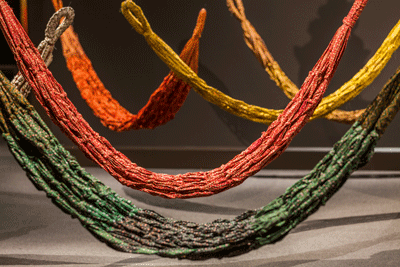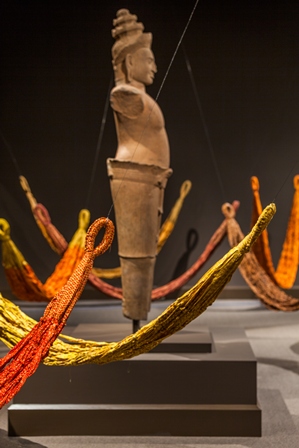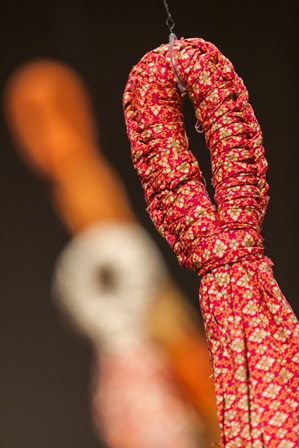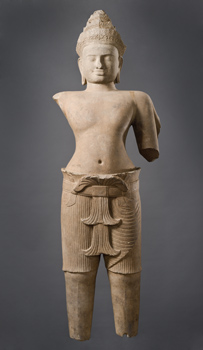In her installation Hanging by a Thread, Pinaree Sanpitak, a Thai conceptual artist, honors a national tragedy (the 2011 Monsoon floods). The work uses a flowers-patterned fabric, a textile very common in Thailand, which Pinaree stated “ . . . proved soothing, and brought back a sense of nostalgia . . . the ordinary. The local.”
 Pinaree Sanpitak, Hanging by a Thread, 2012, courtesy of the artist and Tyler Rollins Fine Art, New York. Installation views, Los Angeles County Museum of Art, 2013 © Pinaree Sanpitak, LACMA/Museum Associates 2013
Pinaree Sanpitak, Hanging by a Thread, 2012, courtesy of the artist and Tyler Rollins Fine Art, New York. Installation views, Los Angeles County Museum of Art, 2013 © Pinaree Sanpitak, LACMA/Museum Associates 2013
On the fourth floor of the Ahmanson Building, 18 hammocks hang in a dark gallery. They look like rare exotic vegetation crafted from the printed cotton textile, the paa-lai. It’s easy to imagine them as forms of the monsoon: terrifying, consuming waters transforming the Chao Phraya River that snakes through Bangkok like some mythic creature. But of course, Pinaree’s art allows all manner of imagery to be contained, and is sometimes so simple as to reveal and mystify all at once.
The hammocks yield to the curvature of the breast, a constant icon of Pinaree’s work. In the subdued gallery, the work occupies the space in a commanding way—the room, in its dark rigidity, is complemented by soft forms that resemble giant DNA strands, which possesses a spiritual air that undoubtedly challenges even the glorious Vishnu statue that Sanpitak’s work surrounds. Trained in Japan and a great admirer of the artist Eva Hesse, Sanpitak’s work often projects the female form as not only an enduring physicality, but also a dynamic spirituality—the Earth Mother (Preah Thorani, the Earth goddess in mythology), one is led to assume.
 Pinaree Sanpitak, Hanging by a Thread, 2012, Courtesy of the artist and Tyler Rollins Fine Art, New York. Installation views, Los Angeles County Museum of Art, 2013 © Pinaree Sanpitak, LACMA/Museum Associates 2013
Pinaree Sanpitak, Hanging by a Thread, 2012, Courtesy of the artist and Tyler Rollins Fine Art, New York. Installation views, Los Angeles County Museum of Art, 2013 © Pinaree Sanpitak, LACMA/Museum Associates 2013
Thailand is a country where Theravada Buddhism (“the way of the elders”) is the national religion. Buddhism is over-present, in this land literally festooned with prangs and stupas, opulent temples, and golden Buddhas. It should not go unremarked, however, that for many older Americans, the image of Siam was through Hollywood’s prism of the frolicking fantasy, the lyrics and drama of Roger and Hammerstein’s The King & I, an unflattering caricature of Rama V, who, for many Thais, is part-god. While modern perceptions of Bangkok are often filtered through tourist scrims as a land of colorful exoticism and lascivious playgrounds, the city’s denizens, and, in particular, the artists, are deeply engaged in Thailand’s cultural awareness.
Pinaree Sanpitak makes no claim as a Buddhist, but her work appears to be suffused with the forms of the religion, such as the stupa and the breast, and somehow with its ideals. Conceptualism, especially in an Asian country that is steeped in the all-consuming ancient teachings of Buddhism, is viewed as somehow more remarkable and relevant. Here a new voice enters an ancient stage and makes present the essence and language of a humanism that places the female presence at the very core of the culture.
 Pinaree Sanpitak, Hanging by a Thread, 2012, Courtesy of the artist and Tyler Rollins Fine Art, New York. Installation views, Los Angeles County Museum of Art, 2013 © Pinaree Sanpitak, LACMA/Museum Associates 2013
Pinaree Sanpitak, Hanging by a Thread, 2012, Courtesy of the artist and Tyler Rollins Fine Art, New York. Installation views, Los Angeles County Museum of Art, 2013 © Pinaree Sanpitak, LACMA/Museum Associates 2013
As museum visitors have made clear to me upon entering the space of the exhibition, the sensuous and curvaceous hammocks seemed to elicit all manner of illusions. There was testimony about pleasure, rest, stillness, flight, secret messages, and the cradle of mother’s embrace. In their shadow form, the figures are like pods, cocoons, or crescent moons as their melancholy silhouettes pattern the carpet.
One visitor confessed, as she quickly made her way through them, that “it felt weird,” and her astonishment was palpable. Even after a simple explanation, she was not appeased. I can only imagine that the sense of death or emptiness or absence or preparation for absence was present, the ghosts of someone—Hanging by a Thread. It is said that for every great truth there’s an opposite great truth. But mostly it was joy, or a simple “that’s cool.”
 The Hindu God Vishnu, Cambodia, 10th century, gift of Anna Bing Arnold
The Hindu God Vishnu, Cambodia, 10th century, gift of Anna Bing Arnold
Perhaps in setting out the extraordinary clues in her work, and presenting art that is cloaked in modernism and using the tension of delicate, maternal materiality that references the very nature of our tenuous beginnings and endings, Sanpitak presents a place of union. In a haunting unknown, the hammocks speak to the thin existential air that art and solace can occupy in a world of joy and sorrow.
Hylan Booker, gallery attendant



